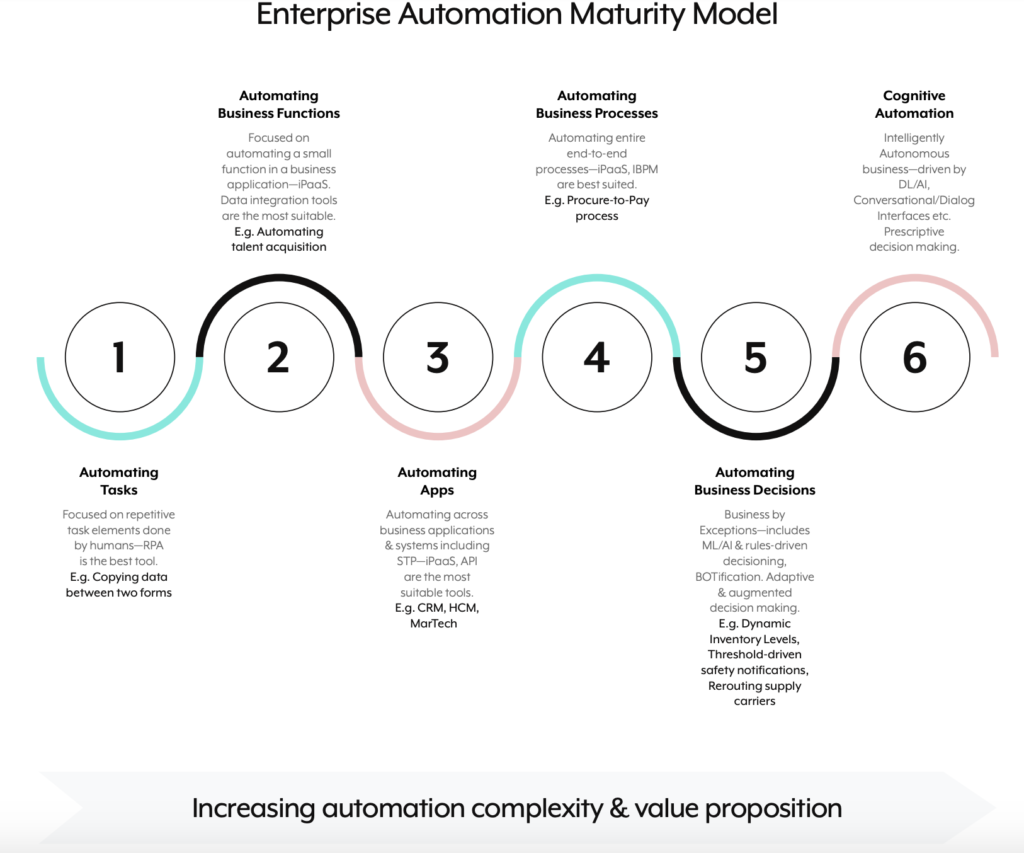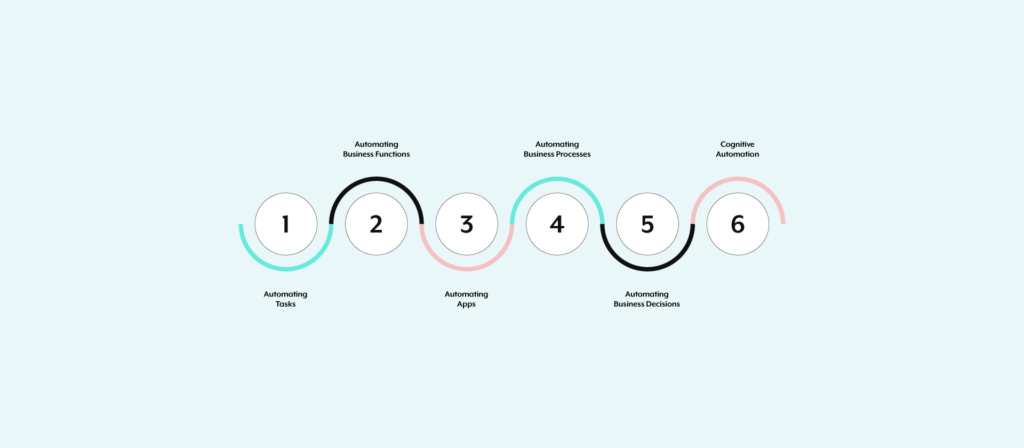A maturity model framework is critical for enterprises looking to deploy automation across business functions—it functions like a GPS, providing a roadmap for success. With differing perspectives and definitions on automation, a framework like this becomes all the more important.
There isn’t a magic tool to solve Enterprise Automation. RPA tools address desktop, screen, and UI-driven automations, BPM tools provide long-running workflow automations, integration tools solve system to system automations, APIs address app centric automations, while Bots address interaction-driven automations.
Instead, think of Enterprise Automation as a spectrum that spans six levels of increasing value and complexity.

Level 1: Automating Tasks
The first level of maturity focuses on automating manual tasks to increase productivity. These can be tasks as simple as copying data between two screens or automating the clicks to create a copy of files that are primarily driven by screen or UI-based automations and document parsing automations. At this level, the focus is mainly on emulating human tasks in order to increase productivity. Piecemeal RPA and OCR processing tools are best suited for this level of automation and easily create business unit impact.
Level 2: Automating Business Functions
The next level of maturity focuses on automations around different business functions. For example, HR’s talent acquisition processes involve candidate screening, interviewing, selection, and offering—processes which could span multiple systems. Automating business functions in these cases primarily revolves around data movement and integration of systems. A data integration or iPaaS middleware would be more efficient in driving automations at this level instead of a screen/click-driven RPA, which tends to be clunky given the nature of intersystem integrations that are required.
Level 3: Automating Apps
This level of automation focuses on automating app-based scenarios. Enterprise app ecosystems have been growing with Cloud adoption and are not showing any signs of slowing down. On average, enterprises use about 25-30 cloud apps, with each cloud app performing a certain amount of business functionality through APIs that provide ease of integration and modularity. In addition, these businesses also use on-premise apps with microservice architectures, which increases the need for automations around them. For example, with Salesforce being used as a CRM application to handle processes like customer data loading and lead management, automations should center around apps that act like systems of records or data hubs for greater impact. iPaaS and API are good tools for enterprises at this level of maturity.
Related: The pros and cons of adopting an iPaaS
Level 4: Automating Business Processes
This level is about automating end-to-end business processes that span multiple business functions, units, teams, systems, and apps. These involve both straight-through processing type automations and human-augmented workflow automations. Human-augmented workflows are more common as end-to-end business processes involve management approvals, employee requests, or reports.
Note that automations at this level must address change management as these processes may evolve. As policies change, the ability to quickly adapt and redefine the workflow is critical. These automations are powered typically by BPM software and workflow systems. Typical examples are procure-to-pay automations, hire-to-retire automations, invoice processing automations, and accounts payable automations.
Level 5: Automating Business Decisions
Here, the focus shifts to gaining the ability to drive business decisions based on pre-defined or deduced criteria. As enterprises adopt AI/ML driven systems of intelligence, training them and interfacing with them to drive business decisions is very much possible, but the extent of human intervention varies.
Automations at this level of maturity focus on running the business by exceptions. When an exception occurs, the resulting business decisions to be made are pre-determined by rule-based automations or data-driven automations. Examples include threshold-driven inventory ordering, fraud detection and notification, and customer offers augmented with behavior intelligence.
Level 6: Cognitive Automation
The highest level of maturity in Enterprise Automation is driven by the core concept of Autonomous Business. It focuses on self-learnt decisions and prescriptive decisions. A good example is robo traders that perform and adapt to HFT scenarios, although this only takes place at an application level now, rather than cognitively, across the enterprise. Still, just imagine all business functions performing like robo traders—while still aspirational at this juncture, this is what some enterprises are currently working towards.
You can learn more about our maturity model and explore additional frameworks and concepts by downloading our whitepaper.
